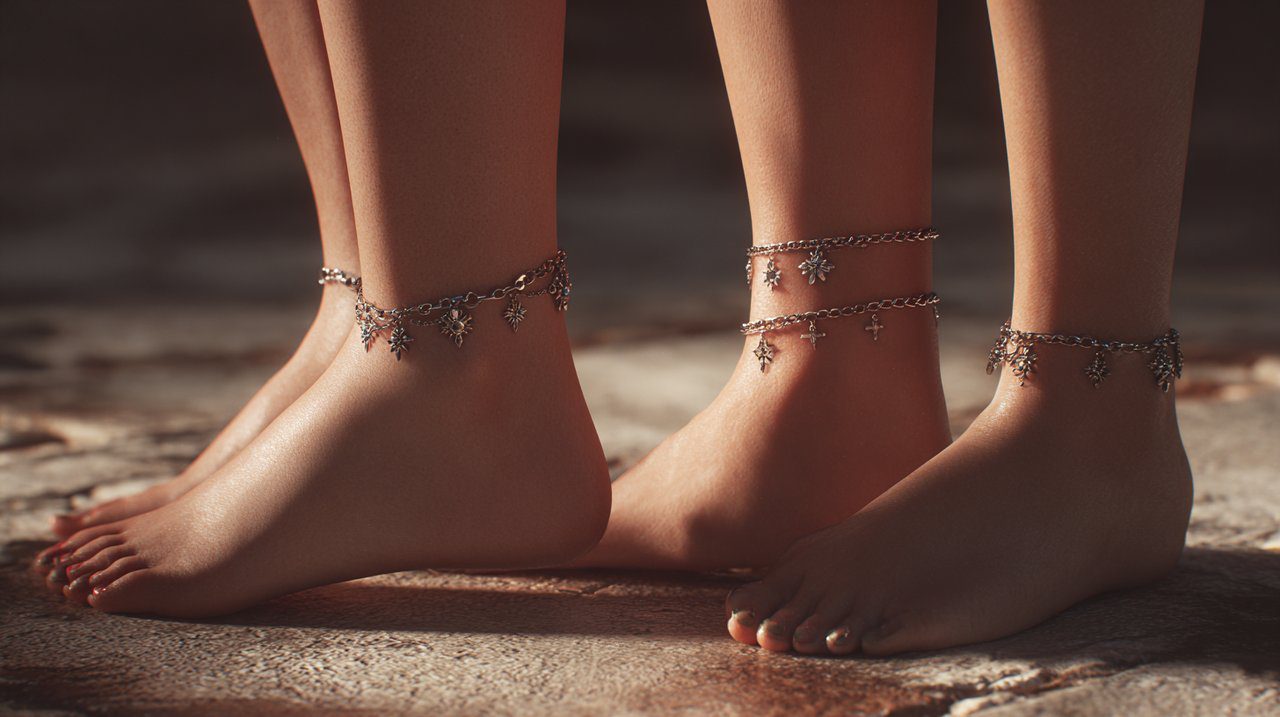The Silent Whispers: Unveiling the Profound Symbolism of Ankle Bracelets
The human form serves as a fundamental canvas for identity. Among varied forms of adornment, the ankle bracelet stands as a distinct cultural and personal marker. While often perceived as a simple accessory, the underlying significance of anklet symbolism extends far beyond ephemeral fashion. These pieces communicate complex narratives, reflecting both established cultural heritage and individual declarations, inviting a deeper understanding of their non-verbal language.
These adornments function as subtle communicators, conveying aspects of the wearer’s inner world and affiliations. A small charm, for instance, might be a deliberate choice, signifying a personal commitment or a significant life event. Such details, though often understated, are integral to the language of personal style, offering insights into individual journeys and beliefs.
The power of an anklet resides in its capacity to serve as a personal marker, a declaration understood by the wearer and often subtly perceived by others. Its significance is rooted in the intimate connection between the individual and their chosen symbol, reflecting a distinct personal perspective rather than overt display.
Anklet Symbolism: Cultural Evolution and Personal Significance
Ankle bracelets have adorned human ankles for millennia, spanning diverse cultures and historical epochs. Their enduring presence suggests a symbolic resonance far beyond ephemeral fashion. Anthropological studies indicate that in ancient Mesopotamia, these adornments often denoted wealth and marital status, while in Indian classical dance, they played a crucial symbolic role in narrative expression. Historical records show that specific anklet designs in ancient Egypt could signify a woman’s social standing or profession. Similarly, certain African tribes incorporated them into significant coming-of-age rituals, marking transitions and communal identity.
As cultural artifacts, anklets embody distinct narratives through their design and material. The profound significance of these pieces arises from the intricate interaction of individual intent, collective heritage, and the non-verbal communication inherent in personal adornment. Semiotic analysis reveals how such symbols accumulate layered meanings across societies, reflecting nuanced interpretations of self and societal roles. For example, the incorporation of ancient Dzi beads into Tibetan jewelry as protective amulets illustrates a rich tradition where adornments are imbued with deep spiritual significance, paralleling how other cultures assign profound value to specific forms of personal jewelry.
Anklets function as potent statements of identity, offering a nuanced form of self-expression that extends beyond aesthetic appeal.
Placement: Left Versus Right Ankle Symbolism
The specific placement of an anklet is rarely incidental, as choosing to adorn the left or right ankle fundamentally reshapes its perceived meaning. This detail elevates a simple accessory into a deliberate declaration, informed by both historical precedents and contemporary individual interpretations. The chosen ankle thus becomes an extension of the message, a non-verbal cue in personal communication.

Right Ankle: Autonomy and Individual Expression
Historically, an anklet on the right ankle has often signified independence, an inclination towards unconventionality, or an openness to new experiences. This placement frequently signals a conscious decision to differentiate oneself or to assert a specific personal stance. It can symbolize a journey of self-discovery, a commitment to personal freedom, or an acknowledgment of non-conformity. In some cultural contexts, it also subtly indicated an individual was unattached or actively seeking new connections.
For instance, during the counterculture movements of the 1960s and 70s, wearing an anklet on the right ankle became a subtle emblem for individuals embracing a bohemian lifestyle, asserting their independent spirit and rejecting traditional norms. This choice signified a path distinct from conventional expectations, reflecting a spirit unconstrained by tradition and charting its own course. Such an adornment, therefore, communicates a deliberate assertion of autonomy and personal liberty.
Left Ankle: Relationship Status and Personal Bonds
Conversely, an anklet on the left ankle frequently signifies matters of the heart and intimate relationships. Historically, this placement has symbolized marital status, engagement, or a committed partnership. In various cultures, a left-ankle anklet acted as a subtle, private pledge, indicating a woman was married or otherwise committed. It can also represent a cherished memory, a significant personal bond, or a hidden promise, anchoring profound emotions.
For example, in some traditional European cultures, a bride might receive a delicate silver anklet, passed down through generations, to wear on her left ankle, symbolizing her enduring vows and familial connections. Its significance derives not from public display, but from its deeply personal resonance. This adornment becomes a tangible link to enduring love or shared history, a testament to vows or cherished memories, a silent pledge worn close to one’s personal sphere.
Gender and Generational Interpretations of Anklets
Societal norms continuously evolve, shaping the interpretations of personal adornment. The significance of female anklets possesses deep historical roots, transitioning from ancient symbols of status and sensuality to contemporary expressions of individual style. Today, women select anklets for diverse reasons, whether for aesthetic appeal or as potent personal statements embodying grace, allure, or growing self-possession. The motivations for wearing these pieces often blend visual appeal with profound symbolic resonance.
While an anklet gifted to a woman might reinforce the left ankle’s traditional association with commitment, this narrative is not exclusively feminine. The growing visibility of men wearing anklets actively challenges traditional gender norms, expanding the symbolism to encompass broader themes of self-expression and individual style across all genders. The choice of which ankle to wear an anklet transcends gender, becoming a deliberate personal declaration. Many also integrate elements of Tibetan jewelry into their selections, adding layers of cultural and spiritual meaning. For instance, pieces featuring evil eye motifs are often chosen for their perceived protective qualities, reflecting a rich synthesis of diverse cultural influences and personal belief systems.
Anklets as Personal Emblems: Symbols of Individual Journeys
For an individual, an anklet becomes a deeply personal emblem, transforming into a private narrative that reflects unique experiences and aspirations. Each charm, material, and placement choice can encapsulate a story known intimately by the wearer, forming a personal language of lived experience. This functions as an intimate form of self-communication, distinct from public declarations. The integration of specific healing crystals into these personal pieces, for example, can further amplify their individual significance, aligning the adornment with personal energetic intentions. The selection of such materials, like the vibrant hues of red agate, often carries its own set of attributed properties and meanings. Red Agate Meaning, Benefits, and How to Harness Its Power
Consider an individual who wears a delicate silver chain, perhaps a gift received upon completing a significant personal challenge; it serves as a tangible reminder of resilience and perseverance. Another might wear a brightly colored bead anklet, each bead collected during a transformative journey, echoing a specific memory or a landscape. At this deeply personal level, an anklet embodies one’s experiences, hopes, and triumphs, transcending its material form.
The significance of such a piece transcends external judgment, fostering an intimate dialogue with the self—a silent conversation between personal identity and adornment. It functions as a canvas for one’s unique mythology, a private testament to an individual’s inner world. For instance, an understanding of one’s Chinese Zodiac sign can inspire personalized charms that reflect specific attributes or aspirations, thereby deepening this profound personal connection.
Modern Interpretations: The Evolving Role of Anklet Symbolism
The symbolism of ankle bracelets continues to evolve, finding new relevance as a subtle form of self-expression. It offers a nuanced counterpoint to overt declarations, serving as a personal statement. The interpretation of an anklet on the left or right ankle is no longer solely dictated by ancient lore but is actively reinterpreted by each generation and individual, reflecting their unique place in society. These adornments underscore the enduring human need for personal symbols—objects that carry significance beyond their material form.
Ultimately, these adornments invite us to discern implicit messages within seemingly simple objects, reminding us that their true beauty often resides not merely in their design, but in the rich stories they encapsulate. Recognizing the anklet as more than a piece of jewelry, we perceive it as a conduit for exploring the intricate relationship between personal identity and the universal language of symbols. This exploration of how objects carry deep cultural and personal meaning is also evident in the rich narratives associated with Jade bracelet chinese meaning: An Enduring Emblem of Heritage and Protection
💡 Frequently Asked Questions
Ankle bracelets are not merely accessories; they are miniature projections of the wearer's inner world, carrying deep personal and cultural symbolism, acting as 'silent whispers' or 'soul's secret tattoos' that convey declarations and affiliations.
Wearing an anklet on the right ankle is often associated with independence, freedom, unconventionality, a journey of self-discovery, or a conscious choice to stand apart and assert autonomy.
An anklet on the left ankle is frequently linked to emotional connections, committed relationships, marital status, or cherished memories, serving as a subtle, private pledge or an emotional anchor.
Yes, while traditionally associated with women, the article notes that men increasingly wear anklets, challenging traditional gender norms and expanding the symbolism to include broader themes of individual self-expression for all genders.







